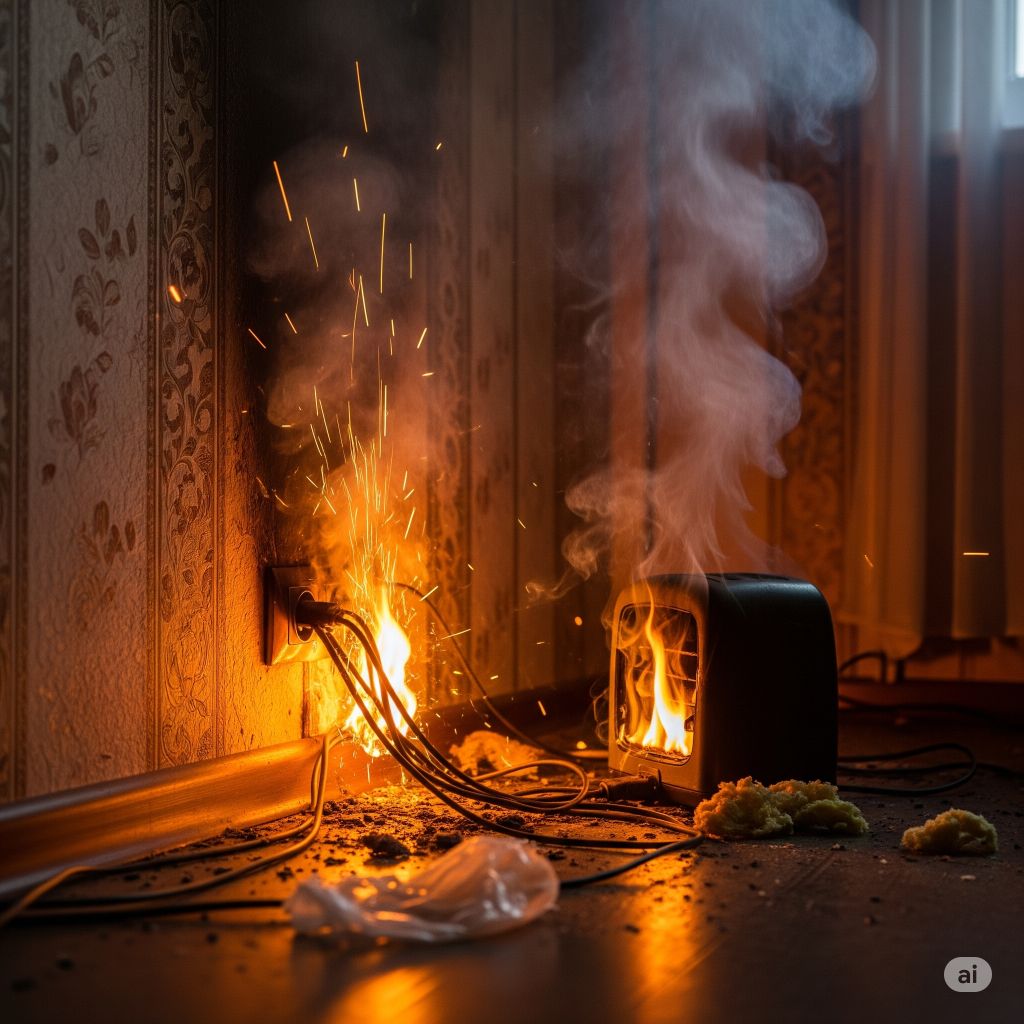
The bedroom is considered a place of rest and safety, but it’s also one of the most common origins of residential house fires—particularly those caused by electrical hazards. According to the National Fire Protection Association (NFPA), electrical malfunctions are a leading cause of fires in U.S. homes, with many of these incidents starting in the bedroom. What makes this space so vulnerable? Let’s explore the hidden risks and how to safeguard your sanctuary.
⚠️ Why the Bedroom Is a Fire-Prone Zone
Bedrooms may not seem as hazardous as kitchens or garages, but they contain multiple high-risk electrical components, including:
- Lamps and light fixtures
- Power strips and overloaded outlets
- Space heaters
- Charging devices (phones, laptops, tablets)
- Faulty wiring
- Electric blankets and heating pads
These items are often left unattended, operate for long hours, or are used improperly, turning a place of relaxation into a dangerous fire zone.
🔥 Key Electrical Hazards in Bedrooms
1. Overloaded Power Strips and Extension Cords
Power strips are convenient, but overloading them is a common mistake. Plugging in multiple high-wattage devices (like space heaters, TVs, chargers, and humidifiers) can:
- Overheat the strip or wall outlet
- Cause sparking or melting
- Start a fire inside the wall from circuit overload
💡 Prevention Tip: Use surge protectors with overload protection, and never “daisy chain” multiple extension cords or power strips.
2. Space Heaters and Heating Devices
Portable heaters are often used in colder bedrooms but can become death traps if:
- Left too close to bedding or curtains
- Tipped over without automatic shut-off
- Left running overnight
🔥 According to the NFPA, space heaters account for over 43% of home heating fires and 85% of related deaths.
💡 Prevention Tip: Use UL-listed heaters with tip-over and overheating protection. Keep a 3-foot safety zone around the heater.
3. Phone and Laptop Chargers
Chargers produce heat and can cause fires, especially when:
- Used with non-certified (cheap) knockoff cables
- Left charging under pillows or blankets
- Plugged into loose or broken outlets
Charging electronics on your bed can trap heat, leading to smoldering or open flames.
💡 Prevention Tip: Only use manufacturer-approved charging equipment and charge on hard, flat surfaces.
4. Faulty Lamps and Light Fixtures
Old or faulty lamps can cause fires due to:
- Loose wiring
- Overheated bulbs
- Tipping and contact with flammable materials
Using high-wattage bulbs in fixtures rated for lower wattages is a major concern.
💡 Prevention Tip: Always match bulb wattage to fixture specifications and avoid placing lamps near drapes or bedding.
5. Electric Blankets and Heating Pads
Electric bedding products, if old or damaged, pose serious fire risks. Common issues include:
- Frayed wires
- Overuse or use with folded areas (causes heat concentration)
- Falling asleep with them on at high temperatures
💡 Prevention Tip: Replace electric blankets every 10 years, never use while folded, and look for auto shut-off features.
6. Hidden or Damaged Wiring
Bedroom fires can start behind the scenes too. Rodents, age, or accidental pinching from furniture can damage wiring. Signs of trouble include:
- Flickering lights
- Burning smell
- Warm outlets or switches
- Tripped circuit breakers
💡 Prevention Tip: Hire a licensed electrician to inspect wiring every 10 years or if you notice odd electrical behavior.
🔎 Bedroom Fire Statistics in the U.S.
Based on NFPA and U.S. Fire Administration (USFA) reports:
| Statistic | Details |
|---|---|
| 🔥 1 in 4 | U.S. house fires start in a bedroom |
| 💡 50% | Electrical malfunction fires begin in sleeping areas |
| 🛏️ 70% | Fatal bedroom fires involve items like mattresses, bedding, or nearby electronics |
| ⚡ 3,800+ | Annual U.S. fires caused by malfunctioning cords and plugs |
| 🚒 51% | Of civilian fire deaths in homes occur during sleeping hours |
🧯 Safety Checklist: How to Fireproof Your Bedroom
Here’s a step-by-step checklist to reduce fire risks:
✅ Do:
- Use smart power strips with surge protection
- Charge electronics on hard surfaces, away from bedding
- Unplug space heaters, chargers, and heated blankets when not in use
- Install and regularly test smoke alarms
- Keep a fire extinguisher or fire blanket nearby
- Have an escape plan practiced with all household members
❌ Don’t:
- Run cords under carpets or rugs
- Plug too many devices into one outlet
- Use extension cords as permanent wiring
- Use damaged cords or plugs
- Sleep with devices charging under pillows
🧠 Pro Tips from Fire Safety Experts
🚒 Tip 1: Upgrade to AFCI Outlets
Arc-fault circuit interrupters (AFCIs) detect dangerous electrical arcs and automatically shut off power — especially helpful in bedrooms.
🛏️ Tip 2: Keep Flammable Materials Away from Lights
Ensure curtains, papers, and clothes are far from heat-emitting devices like lamps or chargers.
🔥 Tip 3: Use Fire-Resistant Bedding
Fire-retardant materials delay flame spread, giving you more time to escape if a fire starts.
👨👩👧👦 Fire Prevention for Families with Kids
Children’s bedrooms are especially vulnerable due to:
- Toys left on chargers
- Nightlights near fabrics
- Overloaded outlets with gaming consoles and gadgets
Teach children:
- Not to touch plugs or outlets
- To unplug devices when done
- To never sleep with a phone under their pillow
🧾 Conclusion: Don’t Sleep on Fire Safety
Bedrooms may feel like the safest space in your home, but they’re among the most dangerous when it comes to electrical fire risk. With the widespread use of electronics, heating devices, and power-hungry appliances, it’s vital to recognize the hazards and address them proactively.
By following smart fire prevention tips and performing regular checks, you can ensure your place of rest doesn’t become ground zero for a devastating house fire.
